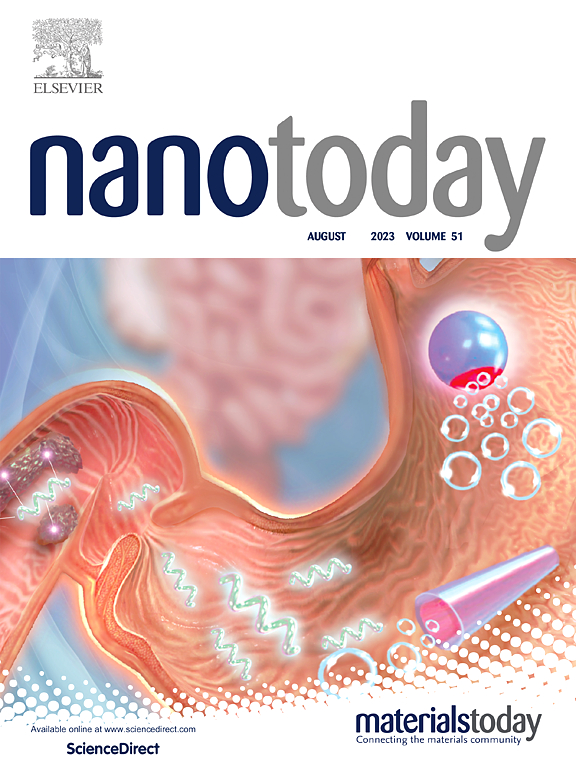The peptide-Au clusters inhibit EGFR exon 19 deletion mutant non-small cell lung cancer
IF 13.2
1区 材料科学
Q1 CHEMISTRY, MULTIDISCIPLINARY
引用次数: 0
Abstract
Epidermal growth factor receptor (EGFR) exon 19 deletions are a common mutation that can lead to non-small cell lung cancer (NSCLC). Here, we designed and synthesized Au clusters coated with EGFR-target peptides to treat EGFR exon 19 deletions mutated NSCLC. Two sequences of peptides (namely P1 and P2 peptide) were designed for synthesis two Au clusters (namely P1-Au and P2-Au), respectively. These two clusters specifically target the extracellular region of EGFR and enter cancer cells through endocytosis. ICP-MS measurements, enzyme activity experiments and cytotoxicity studies in H1650 cells (exon 19 deletions of EGFR) demonstrated that P1-Au clusters have stronger targeting ability towards EGFR, well inhibits EGFR phosphorylation and outcome a better anti-tumor effect than that of P2-Au clusters. Further experiments revealed that the P1-Au clusters enter H1650 cells through the clathrin-mediated endocytosis pathway, escape from lysosomes to the cytoplasm, and inhibit the phosphorylation of EGFR exon 19 deletions and its downstream protein to induce cancer cell apoptosis. P1-Au clusters significantly inhibited the tumor growth in an H1650 xenograft model via suppress EGFR exon 19 deletions mutant activation.
肽- au簇抑制EGFR外显子19缺失突变体非小细胞肺癌
表皮生长因子受体(EGFR)19外显子缺失是一种常见的突变,可导致非小细胞肺癌(NSCLC)。在此,我们设计并合成了涂有表皮生长因子受体靶向肽的金簇,用于治疗表皮生长因子受体19外显子缺失突变的非小细胞肺癌。我们设计了两种肽序列(即 P1 肽和 P2 肽),分别用于合成两个金簇(即 P1-Au 和 P2-Au)。这两个金簇特异性地靶向表皮生长因子受体的胞外区域,并通过内吞作用进入癌细胞。ICP-MS测量、酶活性实验以及对H1650细胞(表皮生长因子受体19外显子缺失)的细胞毒性研究表明,P1-Au簇对表皮生长因子受体的靶向能力更强,能很好地抑制表皮生长因子受体的磷酸化,抗肿瘤效果优于P2-Au簇。进一步的实验发现,P1-Au 簇通过凝集素介导的内吞途径进入 H1650 细胞,从溶酶体逸出到细胞质,抑制表皮生长因子受体 19 外显子缺失及其下游蛋白的磷酸化,从而诱导癌细胞凋亡。P1-Au 簇通过抑制表皮生长因子受体 19 号外显子缺失突变体的活化,显著抑制了 H1650 异种移植模型的肿瘤生长。
本文章由计算机程序翻译,如有差异,请以英文原文为准。
求助全文
约1分钟内获得全文
求助全文
来源期刊

Nano Today
工程技术-材料科学:综合
CiteScore
21.50
自引率
3.40%
发文量
305
审稿时长
40 days
期刊介绍:
Nano Today is a journal dedicated to publishing influential and innovative work in the field of nanoscience and technology. It covers a wide range of subject areas including biomaterials, materials chemistry, materials science, chemistry, bioengineering, biochemistry, genetics and molecular biology, engineering, and nanotechnology. The journal considers articles that inform readers about the latest research, breakthroughs, and topical issues in these fields. It provides comprehensive coverage through a mixture of peer-reviewed articles, research news, and information on key developments. Nano Today is abstracted and indexed in Science Citation Index, Ei Compendex, Embase, Scopus, and INSPEC.
 求助内容:
求助内容: 应助结果提醒方式:
应助结果提醒方式:


